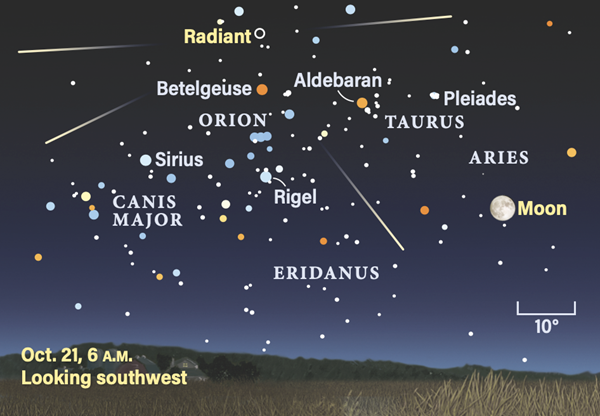Thursday, October 21
The Orionid meteor shower peaks today, but the fainter meteors will have a hard time contending with the still-bright Moon. Our satellite will unfortunately bump down the number of shooting stars you’ll see from the shower’s maximum expected rate of 20 meteors per hour at peak.
Still, if you want to try your luck, the shower’s radiant, which sits 10° north of Betelgeuse in Orion the Hunter, rises around 10:30 P.M. local time this month. But your best bet is to step outside early this morning, when the radiant is 65° high two hours before sunrise and the Moon is several constellations away in Aries. The shower will remain active for another week and a half, but rates will drop dramatically after today’s peak passes.
Speaking of the Moon, our satellite passes 1.3° south of Uranus at 6 P.M. EDT. The pair rise around 7 P.M. local time, now just over 2° apart in eastern Aries the Ram. Uranus, which is often visible to the naked eye under clear, dark skies, will definitely need some optical aid to spot tonight. Its magnitude 5.7 glow will be lost in the glare of the Moon’s bright light, but you may pick it up with binoculars or a telescope, sitting northeast of the Moon and 11.7° southeast of Aries’ alpha star, Hamal.
Sunrise: 7:17 A.M.
Sunset: 6:11 P.M.
Moonrise: 6:56 P.M.
Moonset: 8:09 A.M.
Moon Phase: Waning gibbous (99%)
Friday, October 22
There’s a dark window tonight between sunset and moonrise when you might be able to catch sight of some of the sky’s fainter objects. Let’s seek out the Owl Cluster (NGC 457), an open cluster in Cassiopeia the Queen that bears a resemblance to the bird for which it is named. (Of course, amateur astronomers are quite creative and this cluster has several other names as well, including the E.T. Cluster and the Kachina Doll Cluster.)
Located 2° southwest of Ruchbah (Delta [δ] Cassiopeiae), the Owl Cluster’s two brightest stars, Phi Cassiopeiae and HD 7902, serve as the bird’s eyes. Neither is actually part of the cluster, however, and instead sit in front of its member stars. With its wings spread, the owl’s body stretches to the northwest. Binoculars or a small scope should show many of the roughly 80 stars that make up this young grouping of stars. They formed some 21 million years ago — a cosmic eyeblink, in terms of the universe’s age.
Sunrise: 7:19 A.M.
Sunset: 6:10 P.M.
Moonrise: 7:24 P.M.
Moonset: 9:10 A.M.
Moon Phase: Waning gibbous (96%)










